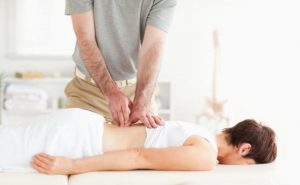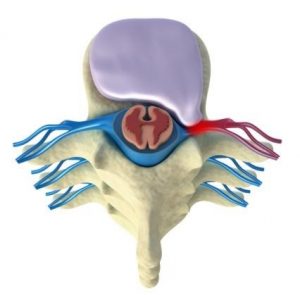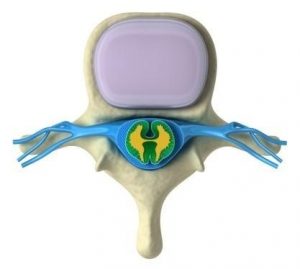TORSO & BACK INJURIES – RIB TRAUMA
Rib trauma is damage to the long rib bones that form the chest wall.
Rib trauma commonly occurs in contact sports or any activity where a forceful blow to the ribs can occur. The damage may range anywhere from bruising to a single or multiple rib fractures.
Once sustained, rib trauma causes sharp intense chest pain at the site of injury and can be aggravated by deep breathing or coughing.
If rib trauma is suspected, cease activity and apply covered ice to the site of injury. Make sure you also see a health professional, as an X-ray may be required. Sports Physio can help rehabilitate rib trauma and strengthen your chest wall so that you can get back to your activity as soon as possible.
LOW BACK PAIN
Low back pain is a non specific diagnosis referring to pain caused by muscles, joints or ligaments in the lower back.
Low back pain results from an injury affecting structures in the back (muscle, ligament, disc, nerve or bone). Most often this type of injury results from everyday movements such as bending forward, lifting or twisting through the spine, but can also result from combined or repetitive movements.
Low back pain is reported by patients as pain in the lower back region. This often presents as a dull or strong ache, which is made worse by movement. In some circumstances, it may prevent people from standing in a normal standing posture, resulting in a lumbar flexion position. The pain may be in the middle of the back, to one side or on both sides of the spine. It can also radiate into the buttocks, back of the thigh or lower leg.
If you have low back pain or any other back injuries you should consult your nearest physiotherapist for assessment, diagnosis and treatment. You should cease regular activities that aggravate the pain until this treatment has occurred to prevent aggravation of your symptoms and may increase recovery time.
Low back pain does not usually have any long-term implications, as long it is properly diagnosed and treated. Recovery can take a number of days to weeks depending on the severity of the condition and response to treatment. Low back pain is most likely to recur when it is poorly managed and treatment is not followed through to completion.
Initially, a physiotherapist will diagnose the problem and determine its severity. This may involve the use of imaging techniques such as an X-ray, CT scan or MRI. From this information, an appropriate treatment plan will be developed. The early phase of treatment is focused on pain reduction and may include a variety of hands on techniques such as soft tissue massage, joint mobilisation and muscles releases in conjunction with electrotherapies, traction, medication, taping and exercises. When your pain has settled , the physiotherapist will be able to provide you with a comprehensive program of stretching and strengthening exercises designed to return you to your regular activities, and reduce the chances of your back pain recurring.
NERVE ROOT COMPRESSION (SLIPPED DISK)
Nerve root compression refers to when a nerve leaving from the spinal column is compressed by a structure within the back.
Nerve root compression most commonly occurs when an intervertebral disc slips (herniates). An intervertebral disc refers to the disc between two vertebral bodies in the back. When this disc is injured, its contents may bulge out into the spinal canal where the spinal cord and the nerves that lead on towards the legs are located. This bulge can result in compression of these structures. The mechanism of injury can occur following, what may be considered, relatively simple movement such as bending forward or twisting the spine, or more complex and forceful movements of the spine.
Nerve root compression is reported as a sudden onset of pain through the lower back and sometimes down the leg. This can be associated with an inability to stand up straight or worsened by sitting, bending, lifting, coughing or sneezing. The pain going into the leg is a result of compression of the nerves to the legs. This type of leg pain has been reported as sharp, shooting, and may or may not be accompanied with pins and needles, numbness or weakness in the legs.
If you suspect you have an acute nerve root compression, you should consult your physiotherapist or general practitioner. If you also have numbness in the groin region and are having difficulty passing urine you should go to your nearest emergency department. If you have a nerve compression you should cease all sporting activities until this type of injury has been assessed by a health professional.
Nerve root compression does not commonly result in any longterm effects, as long as it is appropriately diagnosed and treated. Recovery usually will occur in a number of weeks to months depending on the severity of the compression and symptoms. In some instances this period may be prolonged depending on the size of the disc bulge and extent of compression. In extreme cases surgical intervention may be required.
Initially treatment will involve techniques to reduce your pain such as gentle massage and joint mobilisation, activity modification, anti-inflammatory medications, spinal traction, electrotherapy treatment, retraining exercises or taping of the back. When your pain has settled, you will be provided with a graded exercise rehabilitation program with a series of stretching and strengthening exercises to be reviewed by your physiotherapist in order to return you to your previous activities and decrease the risk of recurrance of the condition.
SACROILIAC JOINT DISORDER
The sacroiliac joint is the joint between the two pelvic bones (sacrum and ilium) at the back of the pelvis and base of the spinal column. Disorders of this joint refer to any condition affecting the structures of the joint or the surrounding soft tissues.
Stresses of the sacroiliac joint are caused by either a “locking” or “unlocking” of the joint. The excessive movement stresses the ligaments and soft tissue structures that support the joint, or the lack of movement causes incorrect muscle patterning and increased tightness of muscles required for stability. Continual tightness or overstretching of the joint can result in pain and inflammation of the sacroiliac joint.
Sacroiliac joint disorders generally cause pain, stiffness and incorrect muscle patterning. This is reported to be in the very low in the back or buttocks. It is usually only felt in one buttock, but may be present on both sides. The pain is commonly being reported as referring to the groin or the front and outside of the thigh.
If you have or feel you may have a sacroiliac joint disorder, you should contact your physiotherapist or general practitioner for assessment and management of the condition.
Sacroiliac joint disorders will generally resolve completely with appropriate treatment. Recovery usually takes place in a number of weeks or months.
Initially, physiotherapy treatment will involve activity modification, the use of antiinflammatory medications, soft tissue treatment such as massage, mobilisation and stretching, taping and the progression through a series of specific strengthening exercises. In severe cases an injection of cortisone may be required.



